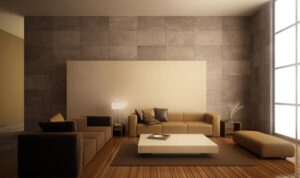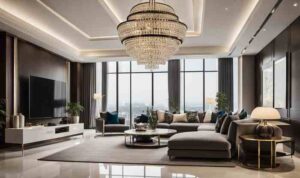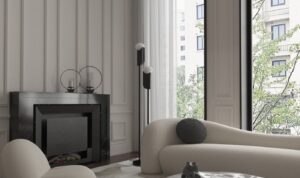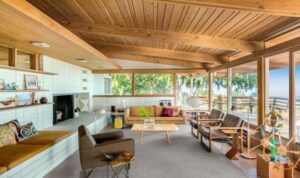As interior wall design takes center stage, this opening passage beckons readers into a world crafted with good knowledge, ensuring a reading experience that is both absorbing and distinctly original.
Interior wall design plays a crucial role in the overall aesthetics and functionality of a space. From choosing the right finishes to incorporating color schemes and patterns, every decision impacts the ambiance of a room. Let's delve deeper into the art of interior wall design.
Understanding Interior Wall Design

Interior wall design refers to the process of selecting and arranging elements such as paint, wallpaper, textures, and decorative features on the walls of a room to enhance its aesthetic appeal and functionality. It plays a crucial role in interior decor as it sets the tone and mood of a space, creating a harmonious and visually pleasing environment.
Interior wall design is essential in creating a cohesive space by tying together the overall theme and style of a room. By carefully choosing colors, patterns, and materials for the walls, designers can establish a sense of unity and balance that enhances the overall visual impact of the space.
The Role of Interior Wall Design in Ambiance
Interior wall design has a significant impact on the overall ambiance of a room. The color scheme, texture, and finish of the walls can influence the perception of space, light, and warmth within a room. For example, light-colored walls can make a room feel more spacious and airy, while dark-colored walls can create a cozy and intimate atmosphere.
Types of Interior Wall Finishes
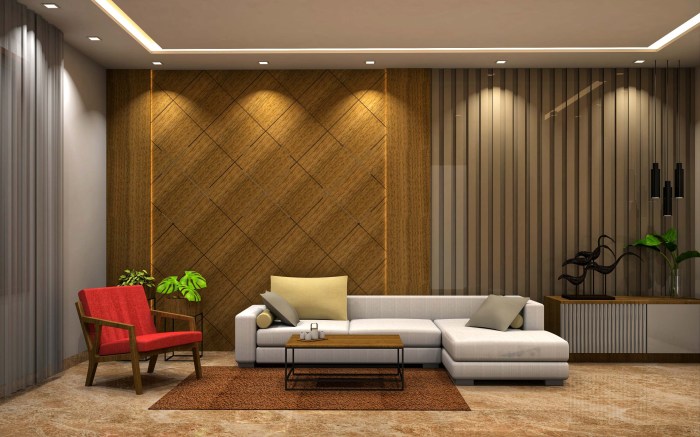
When it comes to interior wall finishes, there are several options available to enhance the aesthetics and durability of your walls. Common types include paint, wallpaper, tiles, wood paneling, and decorative plaster.
Paint
Paint is one of the most popular interior wall finish choices due to its versatility and ease of application. It comes in a wide range of colors and finishes, allowing for customization to suit any style. However, paint may require regular touch-ups and can be prone to chipping and wear over time.
Wallpaper
Wallpaper offers a wide variety of patterns, textures, and designs that can add depth and character to a room. It is relatively easy to install and can be a great way to make a bold statement. On the downside, wallpaper can be difficult to remove and may not hold up well in high-moisture areas.
Tiles
Tiles are a durable option for interior wall finishes, especially in areas prone to moisture such as bathrooms and kitchens. They are easy to clean and maintain, and come in a variety of materials like ceramic, porcelain, and glass. However, tile installation can be labor-intensive and costly.
Wood Paneling
Wood paneling adds warmth and texture to a space, creating a cozy and inviting atmosphere. It can be stained or painted to match any decor style. While wood paneling is visually appealing, it may require regular maintenance to prevent warping or damage.
Decorative Plaster
Decorative plaster finishes like Venetian plaster or stucco add a touch of elegance and sophistication to a room. These finishes can be polished to a smooth or textured surface, creating a unique look. However, decorative plaster can be expensive and may require professional installation for best results.
Color Schemes and Patterns
When it comes to interior wall design, color schemes and patterns play a crucial role in setting the overall tone and ambiance of a space. The right combination of colors and patterns can enhance the style, mood, and visual appeal of a room.
Impact of Color Schemes
Color schemes have a significant impact on interior wall design as they can influence the perception of space, create a sense of harmony, and evoke specific emotions. Here are a few examples of popular color schemes for different interior styles:
- Neutral Palette: A neutral color scheme consisting of whites, beiges, grays, and creams creates a timeless and sophisticated look. It is perfect for minimalist and modern interior styles.
- Monochromatic Scheme: Using varying shades of a single color can add depth and interest to a room. This scheme works well in contemporary and urban chic interiors.
- Complementary Colors: Pairing colors that are opposite each other on the color wheel, such as blue and orange or purple and yellow, can create a vibrant and dynamic look. This scheme is ideal for eclectic and bohemian spaces.
- Analogous Colors: Choosing colors that are next to each other on the color wheel, such as blue and green or red and orange, can create a harmonious and cohesive feel. This scheme is great for creating a calming and relaxing atmosphere in traditional or coastal interiors.
Patterns for Visual Interest
Patterns can be used to add texture, visual interest, and personality to interior walls. Whether through wallpaper, stenciling, or textured finishes, incorporating patterns can elevate the design of a space. Here are some ways patterns can be used effectively:
- Geometric Patterns: Clean lines and geometric shapes can create a modern and sleek look. They are perfect for contemporary and industrial interior styles.
- Floral Patterns: Soft and delicate floral patterns can add a touch of elegance and charm to a room. They work well in traditional and vintage-inspired interiors.
- Stripes and Chevron: Bold stripes or chevron patterns can create a sense of movement and energy in a space. They are ideal for creating a focal point or accent wall in a room.
Texture and Materials
Texture and materials are essential elements in interior wall design as they greatly influence the overall look and feel of a space. The combination of different textures and materials can create visual interest, add depth, and enhance the atmosphere of a room.
Types of Materials for Interior Wall Finishes
- Paint: One of the most common and versatile materials used for interior walls. It comes in a variety of colors and finishes, allowing for endless possibilities.
- Wallpaper: Offers a wide range of patterns, textures, and colors. It can add a touch of elegance or create a bold statement in a room.
- Wood: Provides warmth and natural beauty to a space. Wood paneling or timber cladding can create a cozy and inviting atmosphere.
- Stone: Adds a sense of luxury and sophistication to a room. Stone finishes such as marble or granite can elevate the look of a space.
- Tile: Durable and easy to clean, tile is often used in areas prone to moisture like bathrooms and kitchens. It comes in various sizes, shapes, and patterns.
Impact of Materials on Interior Wall Design
Different materials can significantly impact the overall look and feel of a space. For example, using wood paneling can create a rustic and cozy ambiance, while a sleek marble finish can convey a sense of luxury and elegance. The choice of materials should align with the design style and the desired atmosphere of the room.
Accent Walls and Feature Elements
Accent walls are a popular design technique used to create visual interest in a room by painting or decorating one wall differently from the others. The purpose of accent walls is to add depth, color, and texture to a space, drawing attention to a specific area and creating a focal point in the room.
Creating Accent Walls
- Painting one wall in a bold color while keeping the surrounding walls neutral
- Using wallpaper with a striking pattern or texture on a single wall
- Installing wood paneling or shiplap on one wall to add warmth and dimension
- Creating a gallery wall with framed artwork or photographs
- Adding a large mirror or piece of artwork to make a statement
Feature Elements for Wall Design
Feature elements like moldings, panels, wainscoting, and trim can enhance the overall look of interior walls by adding architectural detail and visual interest. These elements can be painted in a contrasting color to create a striking effect or left in a natural finish to add texture and depth to the walls.
- Installing crown molding at the ceiling to add elegance and sophistication
- Adding wainscoting or beadboard paneling to create a classic, traditional look
- Using decorative wall panels to bring a modern and stylish touch to the space
- Applying chair rail molding to divide the wall into sections and protect it from furniture
- Installing picture frame molding to create a unique and personalized wall design
Closing Summary
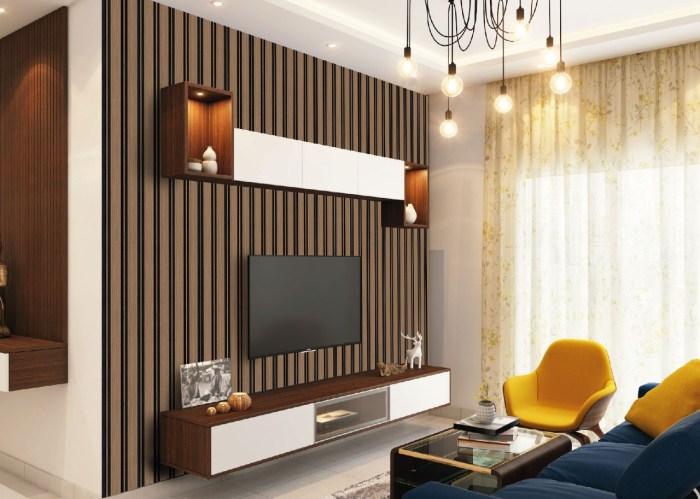
In conclusion, interior wall design is a multifaceted aspect of interior decor that can transform a space from ordinary to extraordinary. By understanding the significance of different finishes, colors, textures, and elements, you can create a space that truly reflects your style and personality.
Embrace the world of interior wall design and let your creativity shine through every wall you touch.
Essential FAQs
What is the significance of interior wall design?
Interior wall design is crucial in creating a cohesive space by impacting the overall ambiance and aesthetics of a room.
What are some common types of interior wall finishes?
Common types include paint, wallpaper, tiles, and more.
How do color schemes affect interior wall design?
Color schemes play a key role in setting the tone and style of a space through the use of different colors and combinations.
What role do accent walls play in interior design?
Accent walls are used to create focal points in a room and add visual interest through different techniques and materials.
How does texture impact interior wall design?
Texture adds depth and dimension to walls, influencing the overall look and feel of a space.


